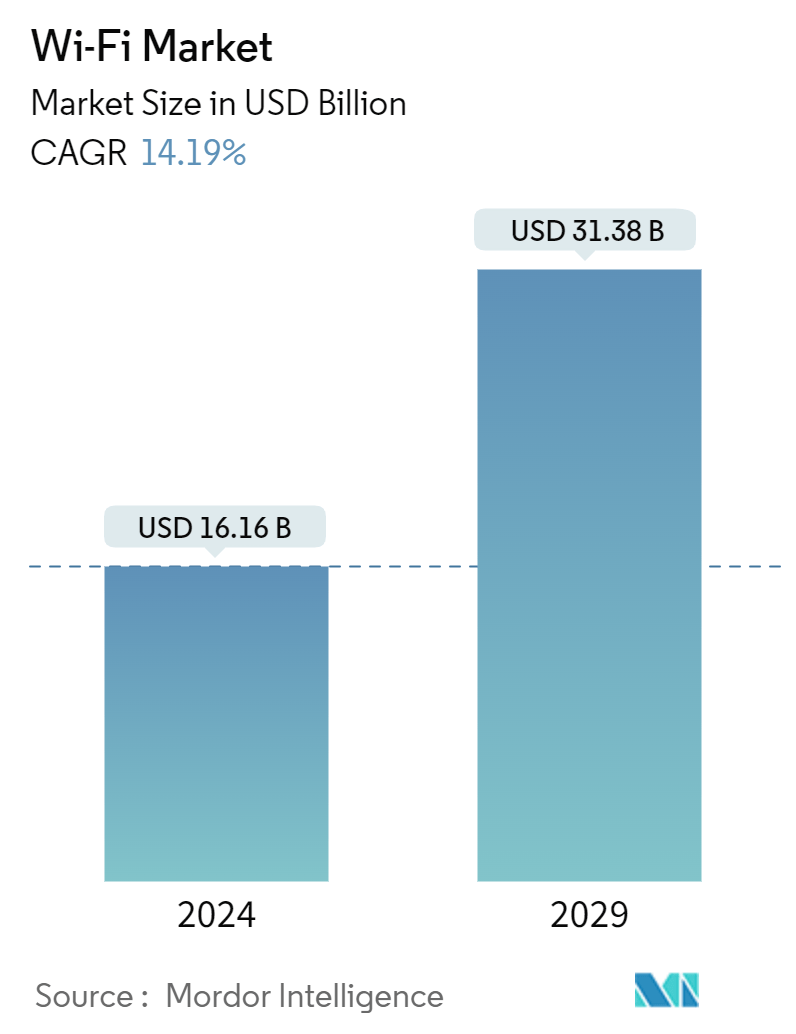Market Size of Wi-Fi Industry

| Study Period | 2019 - 2029 |
| Market Size (2024) | USD 16.16 Billion |
| Market Size (2029) | USD 31.38 Billion |
| CAGR (2024 - 2029) | 14.19 % |
| Fastest Growing Market | Asia Pacific |
| Largest Market | North America |
Major Players
*Disclaimer: Major Players sorted in no particular order |
WiFi Market Analysis
The Wi-Fi Market size is estimated at USD 16.16 billion in 2024, and is expected to reach USD 31.38 billion by 2029, growing at a CAGR of 14.19% during the forecast period (2024-2029).
The Wi-Fi market is experiencing a significant transformation due to rising consumer demand and an evolving technological landscape. Wi-Fi technology has become indispensable in both consumer and business environments, powering everything from home Wi-Fi networks to large-scale enterprise solutions. As Wi-Fi routers and mesh systems continue to advance, they are shaping the future of wireless connectivity, particularly with the adoption of the Wi-Fi 6 standard. This new generation promises enhanced performance, faster speeds, and increased reliability in high-density environments, offering solutions to modern connectivity challenges.
Rise in Demand for Smart Consumer Electronics Devices
- Increasing Need for Seamless Connectivity: The surge in demand for smart consumer electronics is a major driver for Wi-Fi market growth. Consumers in North America, Europe, and Asia-Pacific increasingly rely on Wi-Fi-enabled devices like smartphones, tablets, smart home appliances, and wearables. This trend has fueled the expansion of home Wi-Fi networks, increasing the demand for robust Wi-Fi infrastructure across residential and commercial settings.
- Connectivity Across Devices: As households integrate smart lighting, security systems, and voice-controlled assistants, maintaining high-speed, reliable Wi-Fi becomes critical. Wi-Fi routers and mesh systems are essential in meeting the increasing connectivity needs of these interconnected devices.
- Entertainment and Work from Home: Streaming services, video conferencing, and cloud gaming are putting pressure on home networks. The rise in remote work and online entertainment has made Wi-Fi technology crucial for smooth, uninterrupted experiences in productivity and leisure activities.
- Wi-Fi 6 Driving Growth: The adoption of Wi-Fi 6 is a major trend in addressing bandwidth challenges created by multiple device usage. Wi-Fi 6 provides greater device density and faster data transmission, making it an ideal solution for today’s interconnected consumer electronics landscape.
Smart City Projects and Outdoor Wi-Fi Deployment
- Urban Connectivity Initiatives: Smart city projects are playing a significant role in the development of the Wi-Fi market. Cities across emerging regions such as Southeast Asia, the Middle East, and parts of Africa are deploying public Wi-Fi hotspots and advanced wireless network infrastructure to build connected urban environments. These projects are integral to broader digital transformation efforts, especially in regions aiming to enhance urban connectivity.
- Public Wi-Fi Access: Public Wi-Fi hotspots support smart city functions by offering enhanced connectivity for residents, tourists, and businesses. Urban Wi-Fi networks are essential for municipal services such as transportation, utilities, and public safety, further emphasizing the role of Wi-Fi in building smarter cities.
- Government Initiatives: National governments are heavily investing in Wi-Fi infrastructure to improve communication, enhance security, and foster economic development. By providing free or subsidized Wi-Fi in public spaces like parks, libraries, and transport hubs, governments are ensuring connectivity across urban and rural areas.
- Partnerships with Industry Leaders: Public-private partnerships are key to the success of smart city projects. Industry giants like Cisco, Ericsson, and Huawei are collaborating with local governments to deploy Wi-Fi infrastructure and offer technological support. This cooperation strengthens the development of Wi-Fi connectivity solutions in smart urban settings.
Ongoing Technological Advancements in Wi-Fi
- Enhanced Capabilities of Wi-Fi 6: Wi-Fi technology has evolved significantly with the emergence of Wi-Fi 6, which has become a game changer in the wireless network market. Wi-Fi 6 offers critical enhancements that make it suitable for a wide range of applications, from residential to large-scale enterprise Wi-Fi networks.
- Faster Data Transmission: Wi-Fi 6 enables faster data transfers, reduced latency, and improved performance in congested networks. This resolves many of the bandwidth limitations experienced by previous Wi-Fi generations, especially in environments with high device density.
- Higher Device Capacity: One of Wi-Fi 6’s major advantages is its ability to handle more devices without compromising on network speed or stability. This feature is particularly valuable in high-density environments like stadiums, conference centers, and smart cities, where seamless connectivity is essential.
- Energy Efficiency Improvements: Wi-Fi 6 introduces new energy-saving features that enhance the efficiency of IoT devices and other battery-powered electronics. This results in longer battery life, which is especially crucial for enterprises adopting large-scale Wi-Fi solutions.
WiFi Industry Segmentation
Wi-fi is a trademarked term that denotes wi-fi-certified WLAN-based connectivity products that enable communication for various devices over the internet. The recent rise in the number of devices connected over the internet and the demand for external wi-fi communication has significantly driven the need for these connectivity products. The study focuses on tracking the market growth and forecasts for various products, such as access points, gateways, extenders, routers, and services. The study analyzes the evolution of Wi-Fi-based communication that has led to the recent launch of Wi-Fi 6, which is touted as the next-generation standard in the technology.
Wi-Fi market is segmented by product (access points, gateways, routers, and extenders), application (residential, enterprise, and education), outdoor (public services, transportation, and public utilities), and geography (North America (United States, Canada), Europe (Germany, United Kingdom, France, rest of Europe), Asia-Pacific (China, Japan, South Korea, rest of Asia-Pacific) and Latin America and Middle East and Africa). The market sizes and forecasts are provided in terms of value (USD) for all the above segments.
| By Product Type | |
| Access Points | |
| Gateways | |
| Routers and Extenders | |
| Services (Design, Implementation, and Support) | |
| Other Device Types | |
| Other Solutions |
| By Application Type | |
| Indoor (Residential, Enterprises, Education) | |
| Outdoor (Public Services, Transportation, Public Utilities, Etc.) |
| By Geography | ||||||
| ||||||
| ||||||
| ||||||
| Latin America | ||||||
| Middle East and Africa |
Wi-Fi Market Size Summary
The Wi-Fi market is experiencing significant growth, driven by the increasing demand for wireless connectivity across various sectors. The shift towards remote work and the rise of bandwidth-intensive applications, such as IoT devices, voice, and video communications, have underscored the importance of robust Wi-Fi networks. This demand has led to congestion in existing spectrums, prompting a push for the allocation of the 6 GHz spectrum. The integration of edge computing and 5G technologies with Wi-Fi 6 has further enhanced the need for low-latency, real-time communications, supporting the proliferation of smart homes and connected devices. The market is characterized by the transition from traditional wired networks to wireless local area networks (WLANs), offering flexibility and convenience for both residential and commercial users.
The competitive landscape of the Wi-Fi market is marked by the presence of major players who are actively expanding their global footprint through strategic partnerships and acquisitions. Companies are focusing on enhancing their product offerings with advanced technologies, such as Wi-Fi 6 and 6E, to meet the growing consumer and enterprise demands. Innovations in Wi-Fi technology, including the introduction of Wi-Fi 7 devices and enhanced security features, are shaping the market dynamics. Regions like Asia-Pacific, particularly China and South Korea, are leading in the adoption of Wi-Fi technologies, supported by government initiatives and investments in smart city developments. The market's growth is further bolstered by the increasing number of internet users worldwide, creating opportunities for Wi-Fi router manufacturers to introduce new products and capture a larger market share.
Wi-Fi Market Size - Table of Contents
-
1. MARKET DYNAMICS
-
1.1 Market Drivers
-
1.1.1 Rise in Demand for Smart Consumer Electronics Devices
-
1.1.2 Smart City Projects and Outdoor Wi-Fi Deployment
-
1.1.3 Ongoing Technological Advancements in Wi-Fi
-
-
1.2 Market Challenges
-
1.2.1 Stringent Government Guidelines and Data Regulations
-
1.2.2 Operational Challenges in Denser Environments
-
1.2.3 Concerns Related to Implementation in Outdoor Areas
-
-
-
2. MARKET SEGMENTATION
-
2.1 By Product Type
-
2.1.1 Access Points
-
2.1.2 Gateways
-
2.1.3 Routers and Extenders
-
2.1.4 Services (Design, Implementation, and Support)
-
2.1.5 Other Device Types
-
2.1.6 Other Solutions
-
-
2.2 By Application Type
-
2.2.1 Indoor (Residential, Enterprises, Education)
-
2.2.2 Outdoor (Public Services, Transportation, Public Utilities, Etc.)
-
-
2.3 By Geography
-
2.3.1 North America
-
2.3.1.1 United States
-
2.3.1.2 Canada
-
-
2.3.2 Europe
-
2.3.2.1 United Kingdom
-
2.3.2.2 Germany
-
2.3.2.3 France
-
2.3.2.4 Rest of Europe
-
-
2.3.3 Asia Pacific
-
2.3.3.1 China
-
2.3.3.2 Japan
-
2.3.3.3 South Korea
-
2.3.3.4 Rest of Asia-Pacific
-
-
2.3.4 Latin America
-
2.3.5 Middle East and Africa
-
-
Wi-Fi Market Size FAQs
How big is the Wi-Fi Market?
The Wi-Fi Market size is expected to reach USD 16.16 billion in 2024 and grow at a CAGR of 14.19% to reach USD 31.38 billion by 2029.
What is the current Wi-Fi Market size?
In 2024, the Wi-Fi Market size is expected to reach USD 16.16 billion.

